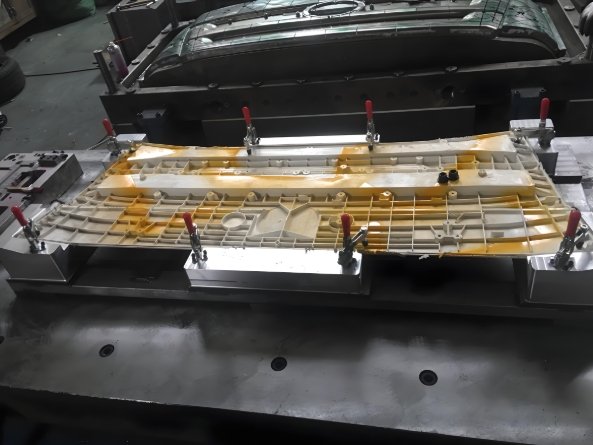
Fuel efficiency is a key factor in the automotive industry. Automotive Injection Molds are crucial in making vehicles lighter and more efficient. A skilled Mold Maker creates parts that reduce vehicle weight, improve aerodynamics, and enhance energy usage.
The Role of Automotive Injection Molds in Reducing Weight
1. Lighter Components
One of the biggest challenges for automakers is weight. Automotive Injection Molds allow for the creation of lightweight parts. Materials such as high-strength plastics and composites replace heavy metals. This reduces the overall weight of the vehicle, improving fuel efficiency.
2. Engineered Precision
Molds create parts with precise shapes and structures. These shapes are optimized for strength and weight reduction. Parts such as bumpers, dashboards, and door panels are made lighter without compromising durability.
How Automotive Injection Molds Affect Aerodynamics
1. Streamlined Designs
Injection molding enables the creation of parts with smooth, streamlined shapes. This reduces drag, helping the vehicle glide more efficiently through the air. Parts like side mirrors, spoilers, and air ducts are designed for better airflow.
2. Fewer Airflow Disruptions
Parts made using injection molds are often free from the imperfections common in other manufacturing methods. This ensures that every piece fits perfectly and minimizes airflow disruptions.
The Impact of Lightweight Materials on Fuel Efficiency
1. High-Strength Composites
Composites such as carbon fiber and fiberglass can be used in Automotive Injection Molds. These materials are strong but much lighter than metals, significantly reducing the weight of the vehicle.
2. Plastic Alternatives
High-performance plastics are increasingly being used in place of heavier metals. Parts such as engine covers, fuel tanks, and chassis components are made from these plastics, offering the same durability and strength.
The Role of the Mold Maker in Creating Efficient Parts
1. Material Selection
A skilled Mold Maker chooses the best materials for fuel efficiency. The right plastic, composite, or polymer ensures that parts are lightweight yet durable.
2. Design Optimization
Mold Makers use advanced simulation tools to optimize the design of each part. By simulating stress and impact forces, they create designs that minimize weight without sacrificing strength.
Reducing Fuel Consumption with Advanced Injection Molding
1. Improved Engine Efficiency
Injection molds can produce complex parts for engine components that help increase efficiency. Lightweight engine parts lead to better performance and reduced fuel consumption.
2. Aerodynamic Components
Parts like underbody panels, front grills, and roof spoilers can be made with injection molds. These components reduce drag and improve aerodynamics, leading to better fuel economy.
The Environmental Benefits of Fuel-Efficient Vehicles
1. Lower Emissions
Fuel-efficient vehicles produce fewer emissions. By reducing fuel consumption, the carbon footprint of a vehicle is lowered.
2. Sustainability in Manufacturing
Using injection molding for lightweight parts reduces the need for raw materials. This leads to more sustainable manufacturing practices.
The Future of Fuel-Efficient Automotive Injection Molds
1. Advanced Materials
The future of Automotive Injection Molds will see even lighter and stronger materials. Innovations in nanomaterials and biodegradable plastics will further reduce the weight of vehicle parts.
2. 3D Printing and Additive Manufacturing
3D printing techniques may allow for even more complex and lightweight mold designs. This could push fuel efficiency improvements even further.
3. Smart Mold Designs
Mold Makers are constantly innovating, creating parts that are not only lightweight but also more efficient in terms of fuel economy. These designs will lead to cars that consume less fuel while offering better performance.
Key Examples of Fuel-Efficient Parts Made with Injection Molds
1. Engine Components
Parts like intake manifolds, valve covers, and air ducts are made using injection molding. These parts contribute to better engine performance and efficiency.
2. Body Panels
Injection molded body panels are significantly lighter than their metal counterparts. They reduce the overall weight of the vehicle, improving fuel efficiency.
3. Bumpers and Trims
Injection molded bumpers and trims are lighter and help improve aerodynamics.
The Benefits of Injection Molding for Automakers
1. Cost Efficiency
Injection molding is a cost-effective process for manufacturing parts. Once the molds are created, the production of parts is fast and inexpensive.
2. Consistency and Quality
Injection molding ensures consistent quality in each part. This is especially important for automakers looking for precision in their vehicles’ components.
3. Shorter Production Times
With the precision of Automotive Injection Molds, automakers can reduce the time spent on production. This allows for quicker delivery of vehicles to market.
Automotive Injection Molds are a critical factor in improving fuel efficiency. Through lightweight materials, optimized designs, and innovative processes, injection molding enables automakers to create vehicles that use less fuel and produce fewer emissions. Skilled Mold Makers play a crucial role in this process, selecting the best materials and ensuring that each part meets the required standards.
By incorporating Automotive Injection Molds into the design of modern vehicles, automakers are reducing the environmental impact while enhancing the performance of their cars. As technology advances, we can expect even more fuel-efficient and eco-friendly vehicles in the future.
